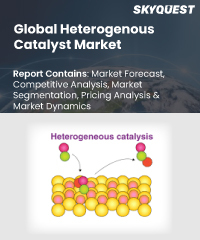
Report ID: SQMIG15G2022

Report ID:
SQMIG15G2022 |
Region:
Global |
Published Date: April, 2024
Pages:
184
|
Tables:
36 |
Figures:
76
Heterogeneous Catalyst Market size was valued at USD 43.6 Billion in 2023 and is poised to grow from USD 45.52 Billion in 2024 to USD 64.24 Billion by 2032, growing at a CAGR of 4.4% during the forecast period (2025-2032).
They need to have a large number of active sites (large surface area) to achieve a high catalytic activity, heterogeneous catalysts are often materials that are nanostructured. Raman spectroscopy is used to analyse heterogeneous catalysts at every stage of their life cycle, including preparation, activation, reaction, and regeneration. The growth of the global market is predicted to continue during the forecast period due to economic expansion in emerging markets, increased awareness of the advantages of Heterogeneous Catalyst costs among developed nations, rising production and expanding capacity in the Chemical industry, and a healthy expansion of the pharmaceutical and food & beverage industries in developing nations. When the phase of the catalysts differs from that of the reactants or products, this is known as heterogeneous catalysis. In contrast, homogeneous catalysis involves the presence of the catalyst, reactants, and products in the same phase. Heterogeneous catalysts typically consist of particles that are introduced to gas or liquid reaction mixtures. The reactants adsorb onto binding sites on the surface of the catalyst in heterogeneous catalysis, and the availability of these reaction sites might restrict the rate of heterogeneous reactions Process optimisation, yield improvement and energy conservation are in high demand among manufacturers worldwide due to the rising need for catalysts from applications such as chemical synthesis, petroleum refining, polymers and petrochemicals, and environmental protection.
US Heterogeneous Catalyst Market is poised to grow at a sustainable CAGR for the next forecast year.
Our industry expert will work with you to provide you with customized data in a short amount of time.
REQUEST FREE CUSTOMIZATIONWant to customize this report? This report can be personalized according to your needs. Our analysts and industry experts will work directly with you to understand your requirements and provide you with customized data in a short amount of time. We offer $1000 worth of FREE customization at the time of purchase.

Report ID: SQMIG15G2022